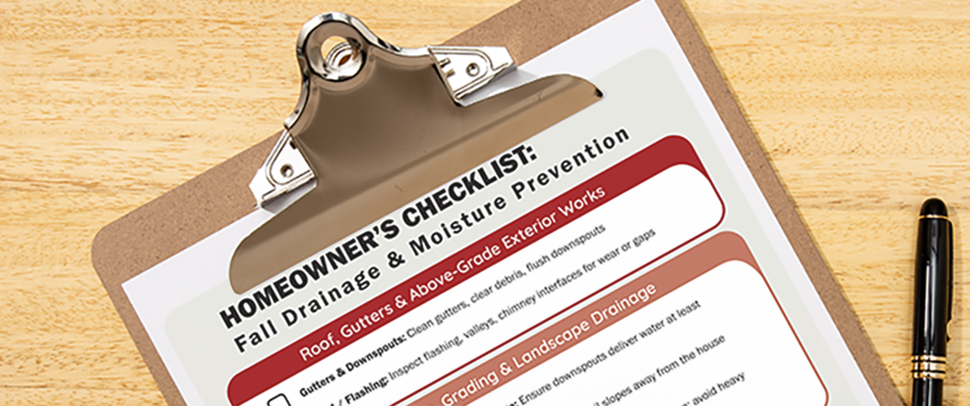Fall Checklist: Moisture Control & Mold Protection for Idaho Homes
As autumn deepens across Idaho, now is the perfect time to address drainage and moisture issues before cold weather and snow take over. Why? Because when water lingers near foundations, in low spots, or behind clogged drains, it can quietly lead to mold, structural damage, and costly repairs.
At Johnny on the Spot Environmental, we’ve seen first-hand how small oversights in fall can turn into major headaches in spring. Use this checklist to stay ahead of trouble and protect your home all season long.
Why Fall Prep Matters More Than You Think
- More precipitation + thaw cycles: Rain, melting snow, and frost cycles as the weather cools tend to saturate soil and reveal weak drainage zones.
- Debris buildup: Leaves, needles, and organic matter clog gutters, downspouts, and surface drains so even a modest rain can overflow.
- Hidden moisture risks: As temperatures drop, indoor/outdoor temperature swings increase the risk of condensation.
- Mold loves standing water: Mold thrives where moisture persists. If water is sitting longer than normal near your home, it becomes a breeding ground. (The Idaho Department of Health & Welfare notes that mold problems in buildings occur when there is too much moisture from leaks or condensation.)
- Repair window is closing: Once the ground freezes or the snow sets in, some fixes become difficult or impossible until spring.
Fall Drainage and Moisture Prep
You can also download the printable Fall Drainage and Moisture Prevention Checklist here >>>

| Area | What to Do | Why It Helps | Pro Tip |
|---|---|---|---|
| Gutters & Downspouts | Clear all leaves, debris, and flush downspouts | Avoid overflow that soaks foundation walls | Use a hose to test flow; if water spills over, you likely have blockage |
| Roof, Flashing & Valleys | Inspect flashing, roof valleys, and chimney interfaces for wear or gaps | Any leak above can saturate walls or insulation | After heavy storms, walk roof carefully (or hire someone) for loose shingles |
| Downspout Extensions / Discharge | Ensure downspouts carry water at least 4–6 ft away (or into underground drain lines) | Prevents water pooling at the base of your home | Use rigid PVC or corrugated pipe—avoid flexible “accordion” drains that clog |
| Foundation Grading & Soil Slope | Confirm the soil around your house slopes away (¼ in per ft or better) | Directs surface runoff outward instead of into your foundation | Add topsoil if needed; avoid compacting soil too close to the walls |
| Landscape & Irrigation | Verify sprinkler heads are away from foundation; avoid heavy mulch right against walls | Landscape systems often do more damage than rain in semi-arid climates magicvalleyrestoration.com+1 | Use drip lines or soaker hoses with proper spacing |
| Window Wells & Exterior Channels | Remove leaves/debris from window wells, check any drains | Prevents water from pooling near basement windows | Add covers over wells during heavy leaf fall season |
| Crawlspaces & Ventilation | Check for moisture, inspect vapor barriers, ensure vents are clear and open | Helps reduce humidity and moisture buildup | If you see condensation, consider mechanical venting or dehumidifiers |
| Interior Humidity & Ventilation | Run dehumidifiers, use exhaust fans, monitor humidity levels | Helps prevent mold even if minor moisture intrusion occurs Idaho Department of Health and Welfare+1 | Aim for indoor humidity ≤ 50–55% in fall |
| Basement / Foundation Walls | Look for cracks, signs of seepage, white powder (efflorescence) or damp spots | Even small leaks feed mold | Use epoxy or polyurethane injection for small cracks; for larger issues, call a pro |
| Seal & Repair Exterior Openings | Caulk cracks, patch siding or masonry, reseal around windows/doors | Prevents water intrusion at weak points | Use exterior-grade sealants that are UV and freeze-thaw resistant |
Best Practices & Things Homeowners Often Overlook
- Start early:
Don’t wait for the first heavy snow! Late fall is your last window for many repairs.
- Document conditions:
Take photos and notes. This is useful for tracking changes or insurance claims.
- Fix the source, not just the symptom: You can scrub mold all you want, but if moisture keeps coming in, it’ll return. The Idaho Department of Health & Welfare strongly advises addressing moisture causes first.
- Know when to call a pro: If you see seepage you can’t stop, recurring drainage failures, or mold over 10 square feet, bring in certified help.
- Climate awareness: In Idaho, you might think dry climate limits mold risk but seasonal shifts, snowmelt, and irrigation can still push excess moisture indoors.
What to Do If You Find Mold or Moisture After the Fact
- Contain & isolate: Close off the area to prevent spores from spreading.
- Dry thoroughly: Use fans, dehumidifiers, and air movers until all materials are bone-dry.
- Clean or remove: Use proper cleaning agents or remove saturated porous materials.
- Repair the moisture source: Until you stop the leak or intrusion, mold will keep returning.
- Call professionals for large infestations: Mold over large areas or deep inside walls often requires professional remediation.
Fall in Idaho may bring crisp air, changing leaves, and a shift in daylight but it also brings higher risk of drainage problems and mold if water is allowed to linger. This season is your best chance to inspect, repair, and prevent. A few hours of prep now can save hundreds (or thousands) later.
When you need help assessing drainage, moisture, or mold risk, Johnny on the Spot Environmental is ready. Contact us today to schedule an inspection or consultation.

